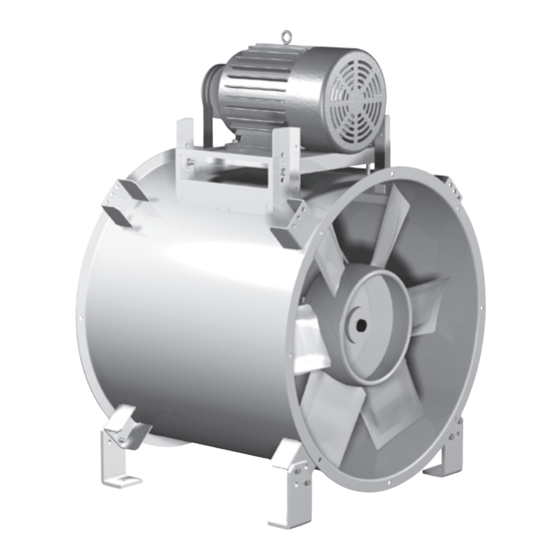
Table of Contents
Advertisement
Quick Links
®
Installation, Operation and Maintenance Manual
Please read and save these instructions for future reference. Read carefully before attempting to assemble, install,
operate or maintain the product described. Protect yourself and others by observing all safety information. Failure
to comply with these instructions will result in voiding of the product warranty and may result in personal injury
and/or property damage.
TDI
General Safety Information
Only qualified personnel should install this unit.
Personnel should have a clear understanding of these
instructions and should be aware of general safety
precautions. Improper installation can result in electric
shock, possible injury due to coming in contact with
moving parts, as well as other potential hazards. Other
considerations may be required if high winds or seismic
activity are present. If more information is needed,
contact a licensed professional engineer before moving
forward.
1. Follow all local electrical and safety codes, as well
as the National Electrical Code (NEC), the National
Fire Protection Agency (NFPA), where applicable.
Follow the Canadian Electric Code (CEC) in Canada.
2. The rotation of the propeller is critical. It must
be free to rotate without striking or rubbing any
stationary objects.
3. Motor must be securely and adequately grounded.
4. Do not spin fan propeller faster than the maximum
cataloged fan rpm. Adjustments to fan speed with
Variable Frequency Drives (VFD) may affect motor
load. If the fan RPM is changed, the motor current
should be checked to make sure it is not exceeding
the motor nameplate amps.
5. Do not allow the power cable to kink or come in
contact with oil, grease, hot surfaces or chemicals.
Replace cord immediately if damaged.
6. Verify that the power source is compatible with the
equipment.
®
TBI-CA
Level 3, 4 and 5
Cast Aluminum Propeller
Models TDI, TBI-CA and TBI-FS
TBI-FS
Level 3, 4 and 5
Fabricated Steel Propeller
Always disconnect, lock and tag power source before
installing or servicing. Failure to disconnect power
source can result in fire, shock or serious injury.
When servicing the fan, motor may be hot enough
to cause pain or injury. Allow motor to cool before
servicing.
Precaution should be taken in explosive atmospheres.
Pour écarter les risques d'incendie, de choc électrique
ou de blessure grave, veiller à toujours débrancher,
verrouiller et étiqueter la source de courant avant
l'installation ou l'entretien.
Lors de toute intervention sur la soufflante, le moteur
peut être suffisamment chaud pour provoquer une
douleur voire une blessure. Laisser le moteur refroidir
avant toute maintenance.
Faire preuve de précaution dans les atmosphères
explosives.
Document 460983
Tubular Inline Fans
DANGER
CAUTION
CAUTION
DANGER
ATTENTION
ATTENTION
Tubular Inline Fans
1
Advertisement
Table of Contents

Summarization of Contents
General Safety Information
Safety Precautions and Hazard Warnings
Follow electrical codes, ensure propeller rotation, ground motor, and heed warnings for electrical, thermal, and atmospheric hazards.
Receiving and Unpacking Procedures
Damage Inspection and Part Verification
Inspect for shipping damage upon receipt and verify all required parts and quantities.
Handling and Storage Guidelines
Proper Handling Techniques
Handle units carefully to prevent coating damage and avoid lifting by motor shaft or housing.
Storage Environment and Maintenance
Store in suitable indoor/outdoor conditions and perform monthly inspections and pre-installation checks.
Lifting Procedures
General Lifting Safety
Do not lift by motor shaft or housing; use appropriate chains, straps, or brackets.
Specific Lifting Methods
Details for flanged housing, mounting brackets, and roof upblast configurations.
Installation Effects on Performance
Duct Configuration Recommendations
Ensure adequate straight ductwork at inlet and discharge for optimal fan performance.
System Drainage Considerations
Recommendations for drain locations in ductwork and drip pans for specific intake types.
Typical Installation Configurations
Mounting Bracket Dimensions and Rails
Provides dimensions for horizontal and vertical mounting hole locations.
High-Temperature Applications
Details on TBI-FS construction for high-temperature duty and cooling air flow.
Field Coating Touch-Up Procedure
Repairing Scratched Areas
Step-by-step guide for cleaning, priming, and top-coating damaged paint.
Environmental Impact on Coating
Note on routine touch-ups needed in coastal regions due to salt or marine air.
Operation and Unit Start-Up
Electrical Connections and Safety
Ensure electrical supply compatibility and adherence to codes for safe connection.
Pre-Start-Up Checks and Adjustments
Verify fasteners, check propeller rotation, and adjust belt drive RPM as needed.
Maintenance Procedures
Fastener and Bearing Inspection
Periodically check fasteners, set screws, and bearing locking collars for tightness.
Bearing Lubrication and Motor Care
Lubricate bearings semi-annually and clean motor exterior for optimal performance.
Belt Tension and Alignment
Ensure proper belt tension and alignment to prevent premature failure.
Fan Bearing Lubrication Schedule
Lubrication Intervals and Grease Types
Charts for standard and synthetic grease lubrication intervals based on fan RPM and bearing bore.
Lubrication Best Practices
Guidelines for adding grease, using correct types, and storage lubrication.
Maintenance Details
Dust, Dirt, and Debris Removal
Clean motor housing and propeller to prevent imbalance and overheating.
Roof Upblast Damper Maintenance
Caution regarding fusible link damper lifters and safety pin usage during servicing.
Parts Identification
Fan Component Diagram
Diagram illustrating major fan components like motor, propeller, bearings, and housing.















Need help?
Do you have a question about the TBI-FS and is the answer not in the manual?
Questions and answers